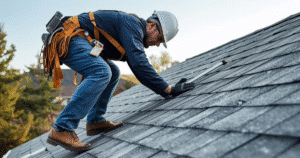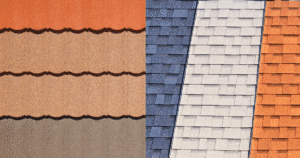• Understand when to replace your roof and the signs that indicate it’s time for a new one.
• Learn the impact of various factors on your roof’s lifespan and the best materials for durability.
• Discover the importance of regular inspections to prevent costly damages and how professional advice can save you money in the long run.
Recognizing the Time for a Change
The roof over your head is essential for shelter and security, so it’s vital to recognize the early warning signs of its wear. A roof that’s past its prime can lead to costly water damage, structural issues, and even health hazards from mold growth. While it may be tempting to ignore small issues, these can quickly escalate into major problems. Spotting issues early can mean the difference between a simple repair and a full roof replacement.
Weathering and Material Fatigue
Years of exposure to the elements can leave a roof looking tired and worn, signaling that it’s time to take action. Look for signs of roof aging such as missing, cracked, or curled shingles, which can lead to leaks and water damage inside your home. In snowy or rainy climates, beware of ice dams or pooled water that can spell trouble for your roof’s integrity. Additionally, a sagging appearance or visible light penetrating through the attic are clear symptoms that your roof’s days may be numbered.
Inspection and Maintenance
Regular inspection and maintenance are your best defense against unexpected roof failures. By scheduling periodic check-ups, either on your own or with a professional, you can catch and remedy small issues like loose nails or wear around chimneys before they become critical. Keeping gutters clean and ensuring proper ventilation are also key in prolonging the life of your roofing system. Remember, spotting and addressing these roof maintenance tips can preserve the longevity of your roof and safeguard your home.
Understanding the Impact of the Elements
Your roof is continuously under siege by the weather, and its resistance to these forces is a testament to its construction and the materials used. Over time, intense sunlight, fierce winds, and heavy rains can diminish your roof’s ability to protect your home. Material choice plays a pivotal role here, as some—like metal or slate—may endure the elements better than others, such as traditional asphalt shingles. It’s important to understand that the right material can greatly extend the life of your roof under your specific local conditions.
Materials Matter
When it’s time to consider a new roof, selecting a material that’s suited to your local climate is critical. With options ranging from modern synthetics to time-tested slate, each has its own merits and lifespans. As a trusted provider of residential roofing services, our aim is to deliver a roof that stands the test of time. Invest in quality materials upfront, and you mitigate the risk of premature replacement, ensuring your home stays secure and dry through the seasons.
Step 1: Assess Your Roof’s Age and Condition
Begin by evaluating your roof’s current state and age. If you know when it was last replaced, this will give you an initial idea of when to consider a replacement. Examine for any visible signs of deterioration, such as missing or damaged shingles, and pay attention to any leaks or light coming through the attic.
Step 2: Understand the Factors Affecting Roof Lifespan
Educate yourself on the factors that impact a roof’s longevity, such as material, climate, and maintenance history. In areas with harsher weather, a roof may need replacement sooner. Different materials like asphalt shingles, metal roofs, or tile have varying lifespans.
Step 3: Conduct Regular Roof Inspections
Commit to regular inspections, either by yourself or by a professional, to catch small issues before they become major problems. Look for signs of wear and tear, and assess the condition of shingles and gutters.
Step 4: Look for Warning Signs
Keep an eye out for red flags, such as water damage in your house, sagging roof decks, and shingle granules accumulating in gutters, which are tell-tale signs that a roof might need replacing soon.
Step 5: Review Your Records
If available, check previous home inspection reports or repair invoices to see the history of your roof. This will help you establish a timeline for its remaining lifespan and any areas of concern that may warrant a replacement.
Step 6: Get a Professional Opinion
Consider hiring a roofing expert to assess your roof’s condition. They can give a more accurate estimate of your roof’s life expectancy and advise on the best course of action.
Step 7: Explore Roofing Materials
Research various roofing materials to decide which suits your home and climate the best. Materials like metal, slate, and asphalt come with different lifespans and price points.
Step 8: Plan for Roof Replacement
If your roof is nearing the end of its life, start planning for a replacement. Get quotes from several contractors, check their references, and create a budget for the investment in your home’s safety and comfort.
Avoiding Common DIY Roofing Mistakes
When it comes to maintaining or replacing your roof, the DIY approach can be tempting, but it often leads to common mistakes that can worsen your roof’s condition and even compromise your home’s safety. A lack of professional expertise might result in overlooking subtle signs of damage or making errors in the repair process. Here’s a list of typical DIY pitfalls and how to avoid them to keep your roof in top shape for as long as possible.
Mistake 1: Ignoring Regular Inspections
Many homeowners wait for a problem to become visible before conducting roof inspections. This reactive approach can miss early warning signs, leading to more significant damage over time. To avoid this, implement a schedule for regular, proactive roof inspections, particularly after severe weather events.
Mistake 2: Overlooking the Climate’s Impact
Underestimating the effect of your local climate on your roof’s lifespan is another common error. Harsh weather conditions, or even not choosing the right materials for your area, can shorten a roof’s life. Stay informed about the best roofing materials for your region’s weather patterns and build your roof accordingly.
Mistake 3: Undervaluing Professional Advice
Some DIYers may dismiss the need for a professional roofer’s assessment to save money. However, this often results in missed diagnoses of potential or existing issues. A professional opinion can help identify problems you may not be equipped to recognize and offer solutions that could save you money in the long term.
Mistake 4: Skimping on Materials
Choosing cheaper, lower-quality materials might save money upfront but can lead to premature roof failure. Investing in high-quality materials that are suitable for your climate and designed for longevity is essential. Research and invest in materials with a proven track record for durability and longevity.
Regular Inspections: The Key to Longevity
Regular inspections can uncover potential issues with your roofing before they escalate into more serious problems. By either conducting self-checks or hiring professionals, homeowners maintain control over the health of their roofing systems. If you discover issues or need an expert eye, consider our comprehensive roofing services to ensure your roof remains in prime condition.
Anticipating Replacement: Timing is Everything
Knowing when to replace your roof is as much about vigilance as it is about timing. If your inspections reveal consistent damage, it may be more cost-effective to plan a replacement rather than pay for ongoing repairs. Planning ahead for roof replacement can alleviate the stress of emergency situations and help you budget for a quality roofing investment.







